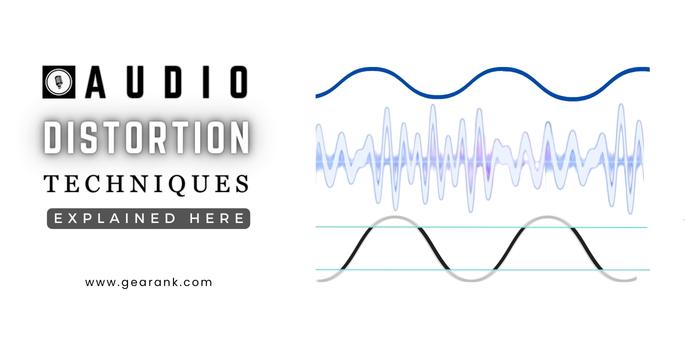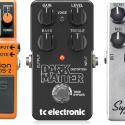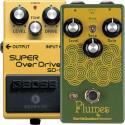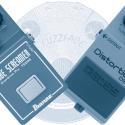Making the Most Out of Audio Distortion Techniques

Audio distortion is an often criticized phenomenon that can be utilized as a creative tool. It is commonly employed on electric guitars as a sound effect and can also be applied to other instruments, including vocals.
However, what exactly causes audio distortion, and how does it emerge from an otherwise normal audio signal?
In this article, we will delve into the technical details of audio distortion and its implications on music.
Table of Contents:
By understanding the intricacies of audio distortion, you can effectively manipulate and utilize it for your benefit. With this knowledge, you can cleverly mold your sound by harnessing this seemingly detrimental effect to achieve unique and creative results.
What is Audio Distortion?
Audio distortion, or distortion, refers to the disruption or alteration of the audio signal. An audio input signal is represented by a sine wave, typically reproduced as accurately as possible by a standard audio component. This means that the speaker produces the signal input close to its original form (sine waves), with minimal changes or alterations.
However, when the sine wave is pushed beyond a specific limit, the sound wave gets truncated as components fail to reproduce the signal accurately. This results in changes to the amplitude or harmonic frequencies of the original signal.
To our ears, this may sound like buzzing or crackling sounds, which accompany the original sound or fundamental frequency components. In the case of components like tubes being pushed, this gives the outgoing signal a thicker, richer sound. While some of these distortions can be pleasing to the ears, others are random and can reduce the overall quality of the sound.
The Two Types of Distortion
Most audio distortion can be classified into two broad categories: linear and nonlinear. These terms refer to how the distortion affects the audio signal.
A frequency-independent change in the signal characterizes linear distortion, whereas nonlinear distortion introduces harmonics and intermodulation distortion products that are not present in the original signal, like crackling, buzzing, or hissing.
Understanding the nature of the distortion is critical to identifying the root cause and implementing appropriate corrective measures.
In music, nonlinear distortion is typically of more significant concern, as it can significantly alter the character of the original sound.
Why Does Audio Distortion Occur?
Audio distortion is a common issue when the input signal surpasses the maximum capacity of the amplifier component, such as a transistor or tube. Every amplifier has a predefined signal-strength threshold that it can handle. In cases where the input signal level goes beyond this limit, the resulting output signal gets clipped and distorted. A few factors that can contribute to unintended distortion include:
-
Nonlinearity and Overloading in Amps: Nonlinear distortion in audio amplifiers can occur when the output signal deviates from a linear relationship with the input signal. This deviation alters the shape of the waveform, resulting in an output sound that is different from the input. Every audio component, including amplifiers, has a maximum capacity or threshold beyond which it cannot handle the signal. When the signal exceeds this threshold, it gets overloaded, leading to clipping. Clipping is a state where the peaks and troughs of an audio waveform are cut off, resulting in distortion.
-
Poor Equipment Quality: In audio systems, one major cause of audioble distortion is poor-quality equipment. Using low-quality cables, connectors, and improper connections that do not meet the standard can cause signal issues, leading to distortion. Additionally, intermittent connections can significantly contribute to signal issues and result in distortion.
-
External Sources: Radiofrequency interference (RFI) and electromagnetic interference (EMI) are some of the most common sources of distortion in audio systems. These types of interference typically originate from communication devices like phones and household appliances like televisions.
However, natural phenomena such as typhoons, solar storms, and flares can also generate such interference. Temperature and humidity are other environmental factors that can impact the performance of audio components, leading to distortion. As an expert, you may already know these external factors and their effects on audio quality.
-
Improper Gain Staging: Improper gain level settings at different stages in the audio signal path can lead to signal clipping. In particular, an elevated gain level at any point in the chain can cause the signal to exceed its maximum amplitude, resulting in distortion or clipping.
-
Impedance Mismatch: When the impedance of two audio components is not matched correctly, it causes a change in the amplitude and frequency response, leading to distortion in the output.
Audio engineers intentionally leverage plug-ins to distort a clean audio signal in music production. Similarly, electric guitarists use pedals that emulate this function, while singers can also achieve distortion of their vocals by manipulating their vocal cords.
How Do You Prevent Distortion in Music?
If you want to prevent unwanted distortion in your mixes, here are some ways to do it.
Set the Levels: When working with a digital audio workstation, it's crucial to monitor your levels during recording, the mixing process, and mastering. Levels refer to the volume of the input signal you're recording in audio production.
A limiter can set a specific clipping point to ensure the signal is recorded within a particular range. This helps avoid clipping distortion when a signal is recorded too strongly.
Another helpful tool is the compressor, which can limit the dynamic range of signals by cutting down strong peaks and troughs in your audio. This results in less chance of clipping and a more controlled output.
High-quality equipment: High-quality equipment is paramount for any musician to achieve superior sound quality.
Premium microphones, cables, amplifiers, and speakers can handle a broader dynamic range, reducing the likelihood of introducing unwanted distortion into the audio signal. Moreover, top-tier equipment is built to last significantly longer than its cheaper counterparts, making it a wise investment both musically and financially.
Furthermore, quality cables feature superior shielding that provides maximum protection against external interference, significantly minimizing the possibility of distortion.
Reduce the Chance of Signal Interference: To minimize interference in audio signals, use balanced cables such as XLRs. These cables have a differential signal that rejects common-mode noise, making them less susceptible to interference. Proper organization of cables, keeping them away from power sources, and avoiding running them parallel to electrical wires can further reduce interference.
Keeping your audio connections away from WiFi networks and electronic devices that can cause interference is essential. Proper grounding of your equipment and connections can also minimize interference.
If you're still concerned about the placement of your connections, you can opt for a ferrite bead that acts as a low-pass filter to attenuate high-frequency noise. Lastly, noise gates or filters can help remove background noise in your audio signal.
Proper Gain Staging: Set the gain levels on each audio gear properly. Avoiding excessive levels at each stage ensures that you'll get an output volume-free or with less distortion.
Set Parameters of Your Plugin: When it comes to distortion use in DAW based music production, avoiding it altogether may not always be the best option.
If used creatively, distortion can be a powerful tool in shaping your sound. To do this effectively, you need to understand the various parameters that come with distortion plugins.
These parameters allow you to manipulate signals and create your desired distortions. Some of the parameters you should expect to see in your distortion plugin include:
-
Filter: This will enable you to selectively distort specific portions of the frequency spectrum. By doing so, you can exercise greater control over the placement and intensity of your distortion effects.
-
Amount/Drive: This allows you to control the degree of distortion applied to the audio. You have the option to saturate the sound and adjust either the input or output gain. Generally, the higher the setting, the more intense the distortion.
-
Dry/Wet: In the audio processing domain, the dry signal refers to the original, unprocessed signal, while the wet signal is the processed or distorted signal. Adjusting the wet-to-dry signal ratio allows you to control the distortion applied to the original sound.
What Are Some of the Applications of Audio Distortion?
Despite its negative connotations, audio distortion can be a powerful tool in shaping sound.
It can be added deliberately to achieve desired artistic effects that would be impossible to achieve otherwise. When utilized judiciously, distortion can positively impact your audio output.
In the following section, we will discuss some of the effects and applications of distortion in audio.
-
Musical Effects: Distortion is a crucial element of rock music, giving it a gritty and energetic sound. Greats like Jimi Hendrix & Eddie Van Halen utilized audio distortion to create their unique tone. In the analog world, guitar amps and pedals with vacuum tubes are preferred for their warm tone generated by harmonic distortion.
Harmonic distortion is produced by adding harmonics like fifths and octaves to the audio signal, resulting in a rich, warm, and pleasing sound.
Tape saturation, another form of analog distortion, is created by the soft clipping on old tape recorders and provides a pleasant sound similar to that of tube amps. There are plenty of tape saturation plugins that do this.
Adding distortion to vocals can be achieved through physical control of the vocal cords while singing or post-production plugins to achieve the desired effect for the song.
-
Spatial Effects: In audio production for movies or video games, intentional distortion is often utilized to achieve a desired soundscape. This technique can provide a sense of spatial depth or produce surreal effects, enriching the auditory experience and facilitating greater audience engagement with the media.
-
Vintage Sound: Vintage audio recordings, specifically those stored on vinyl or tape, are known for their soft clipping distortion. This distortion can be replicated by introducing distortion to the audio signal, resulting in a retro or degraded audio feel that has become a popular genre. The low-fidelity or lo-fi effect is known for its warm, scooped-mid sound and is often accompanied by crackling noise, which adds an old-school feel to the sound. It's essential to set the suitable parameters to achieve this type of sound to get the desired result.
Final Thoughts
Audio distortion is an inevitable phenomenon that can affect the audio quality of music. Musicians need to be mindful of these distortions to avoid the degradation of their audio's purity and clarity.
However, if utilized correctly, distortion can provide a distinct texture to your music. Its unique, warm, gritty, and aggressive sound can add more dimension to your sound.
You can create high-quality music with an exceptional vibe by managing this element. Understanding distortion's impact on your music can help you craft a unique sound that stands out in the industry.
Frequently Asked Questions
Is Distortion the Same As Noise?
In audio and music, distortion and noise are distinct phenomena with different effects on signals. Distortion modifies the shape of a waveform, resulting in characteristic changes such as clipping, saturation, and other nonlinearities.
While distortion can be a deliberate artistic choice, it still contributes to the overall signal. In contrast, noise refers to any unwanted signal that appears alongside the desired signal. It can arise from various sources, such as electrical interference, thermal noise, or environmental factors like wind or traffic.
In audio recording, noise can be particularly troublesome as it reduces the signal-to-noise ratio and degrades the quality of the recording.
Therefore, minimizing or removing noise from the signal chain is crucial to achieve optimal results.
What Is the Difference Between an Overdrive Pedal and a Distortion Pedal?
Electric guitars can be enhanced with various pedals to modify their sound. Overdrive and distortion pedals are two of the most prevalent effects guitarists use. Although both pedals technically distort the electric signals, they do so in distinct ways.
Overdrive is a classic form of electric guitar distortion that was initially a feature of an amp that pushes the signal to oversaturate and eventually distort. It is characterized by its gentle clipping, ideal for rhythm parts in pop and rock music.
Distortion, on the other hand, is a more aggressive type of audio distortion that utilizes hard clipping. It is typically used for lead parts in rock music. More distortion will take you to metal territory identified by heavy distortion. If you're on a tight budget, the best cheap distortion pedal can provide you with the ability to create distortion that is excellent for leads without breaking the bank.
What is Total Harmonic Distortion?
Total harmonic distortion (THD) is a way to measure how much a product's sound gets distorted. It tells us about the extra and unwanted sounds that mix with the original sound.
Sometimes, when we listen to music, we hear noise or sounds we don't expect. THD helps us understand how much noise or unwanted sound is there.
We can measure THD in two ways: as a percentage or as a decibel (dB) value. The THD ratio is always less than 100%, and we can represent it as a negative decibel value.
Contributors:
- Jerome Arcon - Co-writer
- Jerry Borillo - Illustrator












